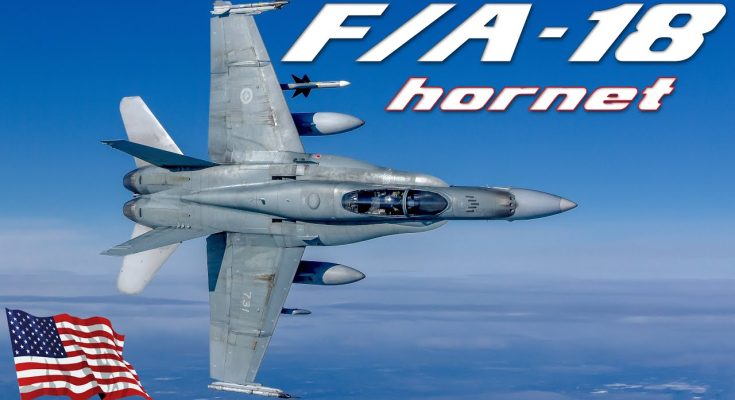The F/A-18 Hornet is one of the most iconic and versatile combat jets in the history of American military aviation. Manufactured by McDonnell Douglas (now part of Boeing), this supersonic, twin-engine fighter was designed to serve as both a fighter and attack aircraft, capable of carrying out a wide range of missions, from air superiority to ground strikes. Since its introduction in the late 1970s, the Hornet has been a cornerstone of naval and air force operations, becoming a symbol of American air power.
Origins and Development: A New Era of Naval Aviation
The F/A-18 Hornet’s development can be traced back to the U.S. Navy’s search for a new multirole aircraft capable of operating from aircraft carriers. The Navy needed a versatile jet that could perform both air-to-air combat and air-to-ground strike missions. In 1974, the Navy issued a request for proposals for the “Lightweight Fighter” program, which eventually led to the creation of the F/A-18. McDonnell Douglas, in partnership with Northrop, won the contract, and the first F/A-18 prototype made its first flight in 1978.
The F/A-18’s design featured a revolutionary combination of a highly maneuverable airframe, a powerful engine, and advanced avionics. Its twin-engine configuration provided the Hornet with the redundancy and safety required for carrier operations, while its sleek, aerodynamic structure allowed it to achieve supersonic speeds and remain highly agile in dogfights. With an advanced fly-by-wire control system, the F/A-18 was capable of maintaining excellent handling characteristics in both combat and tactical missions.
The Versatility of the F/A-18 Hornet
The “F” in F/A-18 stands for “fighter,” while the “A” represents “attack.” This dual-role capability was central to the design of the Hornet, which was envisioned as a multirole aircraft from the outset. The F/A-18 was equipped with a suite of weapons systems, including air-to-air missiles, precision-guided bombs, and rockets, enabling it to engage a wide range of threats. The aircraft could conduct air superiority missions, escort duties, close air support for ground troops, and deep-strike missions against enemy infrastructure.
One of the Hornet’s most notable features was its ability to operate from the U.S. Navy’s aircraft carriers. The design included robust landing gear and tailhook systems that allowed it to land on short, crowded carrier decks, even in difficult weather conditions. This made the Hornet an indispensable asset for naval operations, allowing for rapid deployment and flexibility in combat scenarios around the globe.
Upgrades and Legacy: The Super Hornet and Beyond
Over the years, the F/A-18 Hornet underwent several upgrades to maintain its relevance in the rapidly evolving world of military aviation. In the 1990s, the U.S. Navy introduced the F/A-18E/F Super Hornet, an advanced derivative of the original Hornet. The Super Hornet featured increased size, range, payload capacity, and upgraded avionics, becoming the Navy’s primary carrier-based fighter aircraft. Though the Super Hornet is a distinct variant, it shares many of the same core design principles as the original F/A-18.
The F/A-18 Hornet’s legacy continues today, as it remains in service with several U.S. Navy and allied air forces around the world. Its versatility, reliability, and proven combat record make it a go-to aircraft for modern naval warfare. The Hornet has participated in numerous conflicts, including the Gulf War, the Iraq War, and operations against ISIS, proving its effectiveness in a wide range of combat scenarios.
Key Missions and Global Impact
Throughout its service life, the F/A-18 has played a crucial role in a variety of missions. During Operation Desert Storm in the early 1990s, the F/A-18 was instrumental in enforcing no-fly zones, conducting precision strikes against enemy infrastructure, and ensuring air superiority over the battlefield. Its ability to deliver a wide range of munitions while evading enemy defenses made it a highly effective tool in modern warfare.
The Hornet’s deployment in operations around the world further solidified its reputation as a key asset in U.S. military power projection. Whether conducting air patrols in the Pacific, providing close air support for ground troops in the Middle East, or ensuring naval air superiority, the F/A-18 has been a versatile and reliable platform for U.S. and allied forces.
Conclusion: A Legacy of Excellence
The F/A-18 Hornet, and its later variant, the Super Hornet, represents a remarkable achievement in military aviation. Its development marked a new era for naval aviation, offering a supersonic, multirole fighter that could operate from aircraft carriers with unmatched agility and flexibility. The Hornet’s legacy is not only defined by its combat record but also by its adaptability in the face of changing warfare dynamics.
As the F/A-18 continues to serve with distinction, both in the U.S. and with many allied forces, its contributions to modern military aviation cannot be overstated. The Hornet’s legacy as a supersonic, twin-engine powerhouse that can perform a wide range of roles—from air superiority to precision strikes—cements its place as one of the most successful combat aircraft ever built. In the hands of skilled pilots, the F/A-18 Hornet remains a symbol of American air power, technological innovation, and military dominance.



